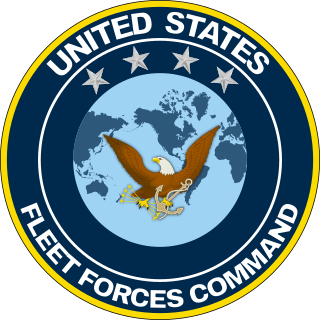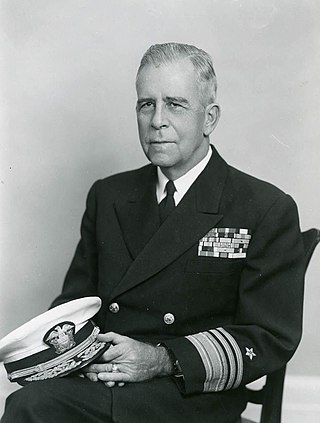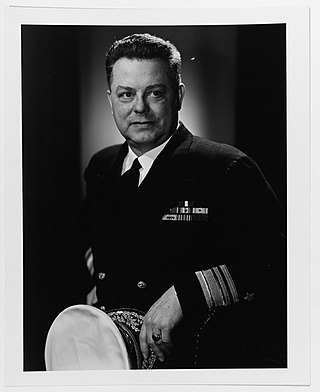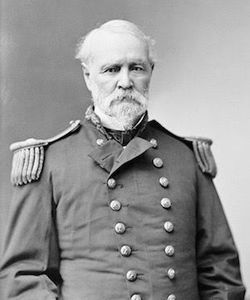
The United States Fleet Forces Command (USFF) is a service component command of the United States Navy that provides naval forces to a wide variety of U.S. forces. The naval resources may be allocated to Combatant Commanders such as United States Northern Command (USNORTHCOM) under the authority of the Secretary of Defense. Originally formed as United States Atlantic Fleet (USLANTFLT) in 1906, it has been an integral part of the defense of the United States of America since the early 20th century. In 2002, the Fleet comprised over 118,000 Navy and Marine Corps personnel serving on 186 ships and in 1,300 aircraft, with an area of responsibility ranging over most of the Atlantic Ocean from the North Pole to the South Pole, the Caribbean Sea, Gulf of Mexico, and the waters of the Pacific Ocean along the coasts of Central and South America.

William Daniel Leahy was an American naval officer. The most senior United States military officer on active duty during World War II, he held several titles and exercised considerable influence over foreign and military policy. As a fleet admiral, he was the first flag officer ever to hold a five-star rank in the U.S. Armed Forces.

William Veazie Pratt was an admiral in the United States Navy. He served as the President of the Naval War College from 1925 to 1927, and as the 5th Chief of Naval Operations from 1930 to 1933.

Montgomery Meigs Taylor was an admiral in the United States Navy. He served in the Navy from 1890 to 1933, fought in the Battle of Manila Bay during the Spanish–American War in 1898, and later commanded the Control Fleet and the Scouting Fleet. He served as commander-in-chief of the United States Asiatic Fleet from 1931 to 1933.

Vice Admiral Robert Lee Ghormley was an admiral in the United States Navy who served as Commander, South Pacific Area during World War II. Ghormley was long considered to be an ineffective leader–overly cautious, pessimistic, and even defeatist–but recent scholarship has shown that while he may not have been an inspiring leader, he performed well under difficult circumstances.

Edward Simpson served as an officer in the United States Navy during the Mexican–American War and the American Civil War, eventually attaining the rank of rear admiral. His service included being assigned as commanding officer of several Navy ships and serving with distinction in various shore assignments.

Charles Turner Joy was an admiral of the United States Navy during World War II and the Korean War. During the last years of his career, while fighting leukemia, he served as Superintendent of the Naval Academy. The destroyer USS Turner Joy (DD-951) was named for him.

John Henry Russell Jr. was a major general and 16th Commandant of the Marine Corps.

Oscar Charles Badger II was an admiral of the United States Navy who served in both World Wars, and, as a junior officer, received the Medal of Honor.

John Russell Young Blakely was a rear admiral of the United States Navy.

John Howard Hoover was a United States Navy admiral who held several flag commands during World War II most notably those in the Central Pacific under Chester W. Nimitz. Hoover became one of Nimitz's trusted if little known admirals of the Pacific war.

Admiral Charles Maynard "Savvy" Cooke Jr., USN, was a United States Navy four star admiral who saw service in World War I and World War II and later served as commander of United States Seventh Fleet (COMSEVENTHFLT) from 1946 to 1947 and commander of U.S. Naval Forces, Western Pacific (COMNAVWESPAC) from 1947 to 1948.

Charles Jackson Train was a rear admiral in the United States Navy. He served in the Spanish–American War and later as the second Commander-in-Chief of the United States Asiatic Fleet.

Rear Admiral Reginald Fairfax Nicholson was an officer in the United States Navy. He fought in the American Civil War and Spanish–American War, was Commander-in-Chief of the United States Asiatic Fleet, and came out of retirement during World War I to serve as the first U.S. naval attaché to Ecuador and Peru. He retired as the last active-duty U.S. Navy officer to have served in the American Civil War.

Bertram Joseph Rodgers was a highly decorated vice admiral in the United States Navy during World War II. He received his Navy Cross as captain of USS Salt Lake City in the battle of the Komandorski islands, during the Aleutian Islands Campaign.

Leo Hewlett Thebaud was an admiral of the United States Navy.

Adolphus Andrews was a decorated officer in the United States Navy with the rank of Vice Admiral. A Naval Academy graduate and veteran of three wars, he is most noted for his service as Commander, Eastern Sea Frontier during the World War II.

Willard Augustus Kitts III was a highly decorated officer in the United States Navy with the rank of Vice Admiral. An ordnance expert and veteran of several campaigns in the Pacific Theater during World War II, he distinguished himself as Commanding officer of heavy cruiser USS Northampton, which was sunk during the Battle of Tassafaronga in November 1942.

Levin Mynn Powell was a rear admiral of the United States Navy. He was known for his service in the Second Seminole War and developing riverine warfare techniques to fight the Seminole. He also served with the Union Navy in the American Civil War.

Henry Lycurgis Howison was a rear admiral in the United States Navy. He was an officer in the Union Navy throughout the American Civil War, participating in the Battle of Port Royal and Battle of Mobile Bay. He later served as professor and department head at the United States Naval Academy.




















